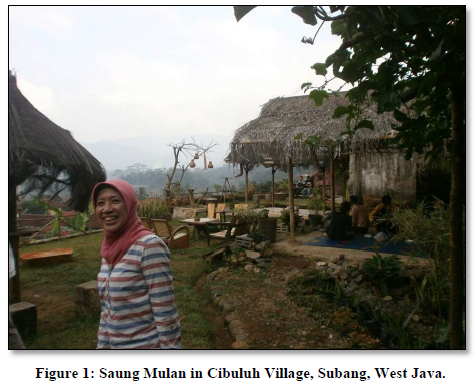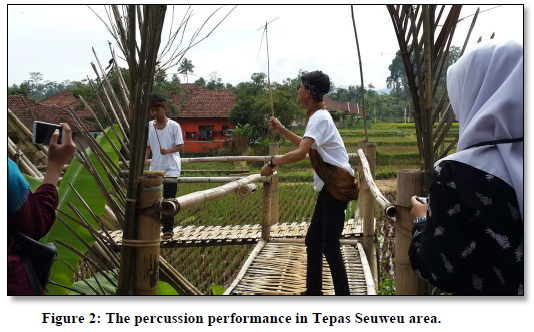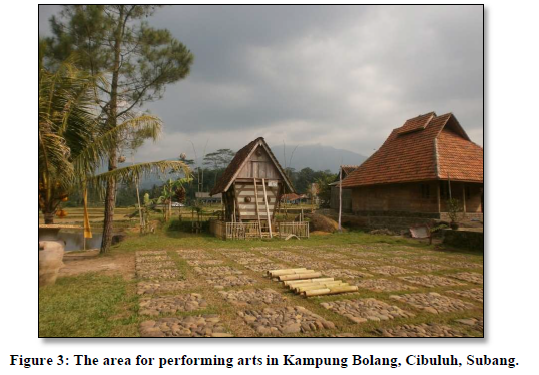4587
Views & Citations3587
Likes & Shares

Tepas Seuweu is defined as Terras where people can hang out. This is located about 500 meters from Saung Mulan. Tepas Seuweu is different from Saung Mulan. In front of Tepas Seuwe location is a ricefield where the people can see the activities of farmers in the rice field. In the Tepas seuweu area (Figure 2), there is a stage for performance, and outdoor space for people to sit and watch the performance, beside the stage, there is a small kios and small cabin without chairs where people can seat and hangout.
Muara Seven Rivers is located in the Southern area of this village, where the director of BUMDES has conducted the Seven Rivers Festival each year since 2016. To promote the tourist destinations, they have worked with Yayasan Bale Bandung, a foundation who has vision to promote tourist destination.
The other community in Cibuluh, namely Hong Community led by Zaini Alief, has developed a model of tourist attraction using traditional games and Sundanese folklore which is called Kampung Budaya Bolang or Bolang Cultural Community (Figure 3). Bolang is the name of the area of community who live in Cibuluh Village. Kampung Bolang tourist destination is located in front of Tepas Seuweu area. There is the area where children can perform traditional game in the outdoor specific site located in between rice field and the river. In terms of participation in tourism development, the people Cibuluh Village is the highest, the missing thing is regular performing arts event.
Therefore, the LIKA 04 Arts Community who stay out of the Cibuluh Village in Subang, work together with the people in Cibuluh in coordination with Unit of Tourism of BUMDES to make a package of performing arts to be performed in Tepas Seuweu location. The question is “How do the arts community developed a package of performing arts based on local wisdom in Cibuluh?”.
Through project-based research method (Stoeker, 2005), we diagnosed the problem, create the concept for arts tourism event, implementing the concept to make the product, and present the performing arts event. Lika 04 Arts Community identified young people and women who stay in Tepas Seuweu area. There are four young men and four young women, and the ladies who are working as farmers (women farmers). Young men and young women as well as the women farmers participated in the project of creating a package of performing arts. Then, we discussed with the people from the unit of tourism of BUMDES Cibuluh Village to identify the local wisdom for creating performing arts. The discussion comes up with the idea of identity of Cibuluh Village in creating bamboo music, because “Buluh” as the name of village means “bamboo.” Therefore, we used arts tourism concept by combining some repertoires based on bamboo’s instruments such as suling or Sundanese flute, kohkol or bamboo percussion, angklung, and dance. The researchers facilitated a set of Sundanese angklung (bamboo music). The Lika 04 Arts Community worked together with the people in Cibuluh to implement the concept of arts tourism offered by Soedarsono (2002). The result is a package of performing arts based on the local wisdom in Subang which is called “Rampak Buluh”.
“Rampak Buluh” consisted of four repertoires such as helaran with angklung and toleat, the music bamboo percussion on the bridge, tarawangsa dance, and angklung music. Helaran is the performance which is presented on the way where the musicians bring and play their bamboo music instruments such as, angklung, suling or toleat, and kohkol. The musicians played the song “tokecang”. The music percussion like kohkol played by young men in the Tepas Seuweu area and on the bridge made from bamboo. The Bamboo music were played on the side of the bridge, and the players stood on the bamboo bridge. The players hit the bamboo instruments with stick made also from bamboo. The players wore black pants and white t-shirts and covered their head with iket. Tarawangsa dance is a creation dance accompanied by the Tarawangsa music. This dance was performed by a couple, yang men and young girl, representing a love story of the rice Goddes. The female dancer wore a pabric with selendang. Her hair was styled in a traditional bun called sanggul, while the male wore black pants and without t-shirt. In the beginning of the performance, the male dancer did not wear a mask, but in the middle of the performance he wore a mask from Cirebon, Klana. This dance represented their thanks to God who have blessed their lives. Angklung music was performed by the women farmers. The women played the Sundanese Song “Kacang Buncis” and “Es Lilin”.
In addition of “Rampak Buluh,” there is Jaipongan performance. Some musicians and the singer of Jaipongan was designed in the tepas seuweu stage. The music gamelan of Jaipongan is familiar in Subang, the rhythme of Kendang stimulated the people to dance. There is no specific dancer for this stage, the audiences could dance if they wanted to.
To evaluate the project, Lika 04 Arts Community invited 50 students from the vocational school in Subang who took their roles as tourists and watched the performance in November 18, 2017. They gave some responses to the performing arts created by Lika 04 Arts Community. The researchers and the Lika 04 Arts Community as well as the persons in charge as a unit of tourism in BUMDES Cibuluh Village evaluated the project in order to sustain the performance as local tourism event. However, Lika 04 Arts Community can’t be the owner because they stay out of Cibuluh and did not continue working in Cibuluh. Fortunately, the women farmers take over responsibility to perform angklung regularly. In the case of Subang, women have a potential to manage local event in the Tourism Village. During the day, the women worked in the ricefield, at night they were eagar to practice angklung music. Also, Nurendra Setya Pamungkas (2013) informed the research that the women in Bejiharjo, Gunungkidul Yogyakarta built the organization of traditional music for arts tourism event.
The women farmers in Cibuluh have become a group of entrepreneurs who perform and received some benefits. In addition, they performed in weddings or governmental events. They also collaborate with Kampung Budaya Bolang, Hong Community, to be practiced and performed angklung music regularly. However, since 2020 when pandemic Covid-19 have attracted Indonesia, all performing arts activities have been stopped.
According to Gianna Moscardo (2008), community participation is one of aspects of community-based tourism (CBT) concept. Oliver Mtapuri & Andrea Giampiccoli (2016) discussed about CBT as a strategy of community development through tourism sectors. This concept of CBT was implemented in Ciater and Cibuluh Villages of Subang. Local community actively participate as performers and facilitators in Wisata angklung Sunda and Rampak Buluh, even though these performing arts events are still low economic income benefit. Ayuningsih, at. al. (2019: p. 8) states that the concept of tourism village emphazes sharing profit system rather than business oriented. The events in Ciater and Cibuluh have meaningful sosial and cultural benefits for tourism development.
CONCLUSION
The process and the result of creating performing arts as local arts tourism events in Subang is the evident of community participation. The ownership aspect of the production of arts tourism event are individuals who are passionate about the performing arts and willingness to manage the event and to share profit with the community. Therefore, local government support is important for managing arts tourism event in order to have economic benefits for community walfare. The other benefits about community participation in tourism village development can reduce urbanization from the villages to the cities and provide jobs for the community.
- Ayuningsih, F., Fridla, H., Teveningrom, S. (2019). Pengembangan Wisata Pedesaan dan Perkotaan, Rancangan Pola Perjalanan [Tourism Villages and Cities Development, Tourism Planning] Gelang Projo (Magelang, Kulon Progo, Purworejo), Belitung Timur, Malang Raya. Jakarta: Kementerian Pariwisata Republik Indonesia [Ministry of Tourism of the Republic of Indonesia]
- Getz, D. & Page, S.J. (2016). Progress in Tourism Management and Prospects for Event Tourism Research. Tourist Management, 52, 593-631.
- Homan, M. (2011). Promoting Community Change. U.S.A. Brooks/Cole, Gengage Learning.
- Masunah, J. et al. (2003). Angklung di Jawa Barat: Sebuah Perbandingan [Angklung in West Java: a comparison]. Bandung: P4ST UPI.
- Masunah, J & Sunaryo, A. (2010). Pengembangan Desa sebagai Laboratorium Sosial & Pendidikan (LABSOSDIK) di Kabupaten Subang, Laporan PkM [Village Development as social and educational laboratorium in Subang District, Community service report]. Bandung: LPPM UPI.
- Masunah, J. & Sunaryo, A (2011). Wisata Angklung Sunda di Wilayah LABSOSDIK UPI Kabupaten Subang, Laporan PkM [Tourism of Sundanese Angklung in the area of social and educational laboratorium of UPI in Subang, Community service report]. Bandung: UPI.
- Masunah, J. (2012). Pemuliaan Angklung melalui Model Desa Binaan berbasis Wisata Seni dan Budaya [Angklung conservation through a model of Village empowerment based on tourism of arts and culture]. Panggung, 22(1), 1-15.
- Milyartini, R. et. al (2012). Pelatihan Angklung Sunda di Cibeusi, Subang. Video PkM [Training of Sundanese Angklung in Cibeusi, Subang. Video of Community service activities]. Bandung: UPI.
- Masunah, J, Nugraheni,T., Sunaryo, A. (2021) Pemberdayaan Komunitas Seni Melalui Produksi Pertunjukan Berbasis Kearifan Lokal Untuk Penguatan Desa Wisata [Empowerment of Arts Community through performance production based on local wisdom for strengthening tourism village]. Journal Abmas, 21(1), 1-10.
- Moscardo, G. eds. (2008). Building Community Capacity for Tourism Development. Cambridge, Massachusetts U.S.
- Narawati, T. (2009). Seni Wisata: Kemasan Industri Kreatif di Jawa Barat. Laporan Penelitian [Arts Tourism: Packaging of Creative Industry sector in West Java], Bandung: UPI.
- Oliver Mtapuri & Andrea Giampiccoli (2016) Towards a comprehensive model of community-based tourism development. South African Geographical Journal, 98(1), 154-168.
- Pamungkas, N.S., (2013). Pemberdayaan Perempuan Melalui Kesenian Karawitan di Bejiharjo, Karangmojo, Gunungkidul [Women Empowerment through traditional music in Bejiharjo, Karangmojo, Gunungkidul]. Diklus Edisi XVII, No. 01, 2013, pp: 200-209.
- Stoecker, R. (2005). Research Methods for Community Change. California: Sage Publication.
- Soedarsono, R.M. (2002). Seni Pertunjukan dalam Konteks Pariwisata [Performing Arts in the Context of Tourism]. MSPI: Bandung.
- Setyorini, H. P. D., Andari, R., Masunah, J. (2019). Analysing Factors for Community Participation in Tourism Development. THE Journal: Tourism and Hospitality Essentials Journal, 9(1), 39-44.
- Vitriya, A. et. al. (2019). Buku Pedoman Desa Wisata [Guidebook for Tourism Village]. Edisi 1. Jakarta: Kementerian Pariwisata [Ministry of Tourism].





